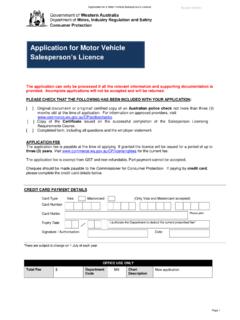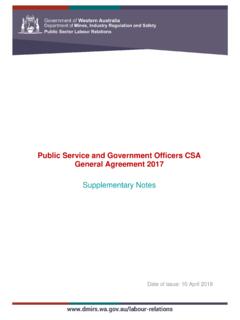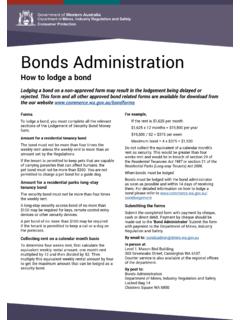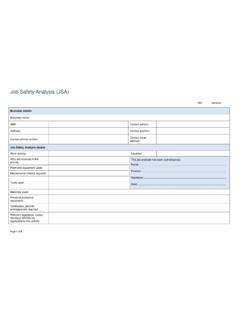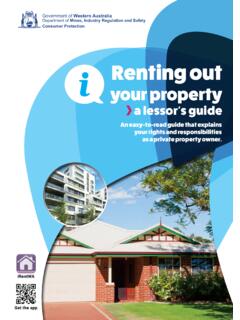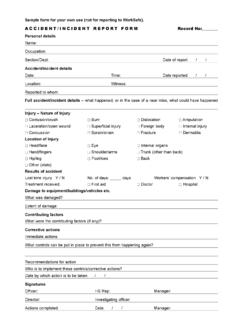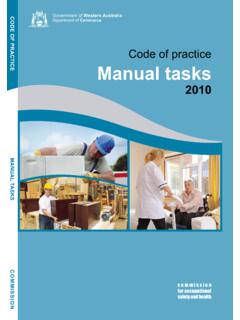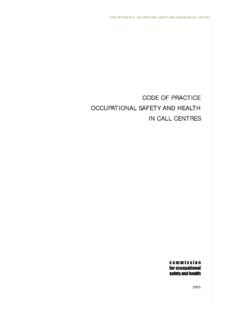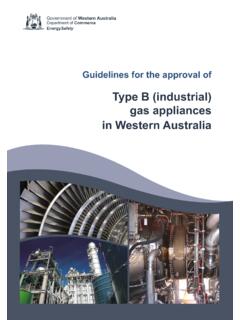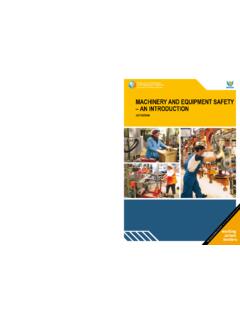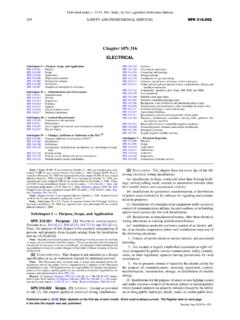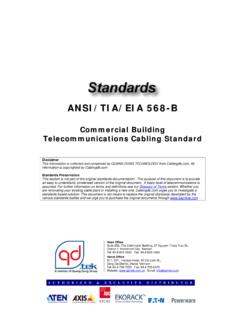Transcription of MS - Guide - testing and tagging portable electrcial ...
1 Guide to testing and tagging portable electrical equipment and residual current devices at workplaces April 2014 Guide to testing and tagging portable electrical equipment and RCDs at workplaces Page 2 of 10 Disclaimer Information in this publication is provided to assist people in meeting occupational safety and health obligations. It is made available in good faith and is derived from sources believed to be reliable and accurate at the time of publication. While information is correct at the time of publication, readers should check and verify any legislation referenced in this publication to ensure it is current at the time of use. Changes in law after this document is published may impact on the accuracy of information. Acknowledgement Parts of this Guide are based, with permission, on Competent Person for testing and tagging Electrical Equipment, published in 2007 by WorkCover New South Wales.
2 Details of publications produced by WorkSafe can be obtained by contacting: WorkSafe Division Department of Commerce Level 5, 1260 Hay Street WEST PERTH WA 6005 Telephone: 1300 307 877 NRS 13 36 77 Facsimile: +61 8 9321 8973 Email: Website: Guide to testing and tagging portable electrical equipment and RCDs at workplaces Page 3 of 10 Contents Disclaimer .. 2 Acknowledgement .. 2 Objective .. 4 Definitions .. 4 What legislation applies? .. 4 Construction and demolition sites .. 4 All other workplaces .. 5 Who may test electrical equipment? .. 5 Who may inspect electrical equipment?.. 6 Who may test residual current devices? .. 6 Construction and demolition sites .. 6 All other workplaces .. 6 What key competencies are required? .. 7 Using a portable appliance tester .. 7 What are the tagging requirements?
3 8 Construction and demolition sites .. 8 All other workplaces .. 8 What needs to be inspected, tested and tagged, and how often? .. 8 Who may authorise workers to test and tag ? .. 9 What happens with damaged or non-complying equipment?.. 9 What records need to be kept? .. 10 Information .. 10 Guide to testing and tagging portable electrical equipment and RCDs at workplaces Page 4 of 10 Objective The Occupational Safety and Health Act 1984 (OSH Act) requires electrical equipment at workplaces to be safe and not expose workers to hazards. As prescribed by the Occupational Safety and Health Regulations 1996 (the OSH regulations), the person having control of a workplace or access to that workplace, employer, self-employed person, main contractor, must ensure that all portable plug-in electrical equipment and residual current devices (RCDs) at the workplace are safe and appropriately inspected, tested and maintained by a competent person.
4 This document will assist with regulatory compliance by providing guidance on who can inspect and/or test and tag such portable equipment and devices. The Occupational Safety and Health Regulations 1996 (the OSH regulations) to , and ) Definitions The term electrical equipment is used here to describe electrical articles that are not part of a fixed electrical installation but are intended to be connected to an electricity supply (either fixed installation or generator) by a flexible cord or connecting device. Typical examples are portable , hand-operated and moveable plug-in electrical appliances, flexible extension cords and power outlet devices. The term residual current device means a device intended to isolate supply to protected circuits, socket-outlets or electrical equipment in the event of a current flow to earth that exceeds a predetermined value.
5 What legislation applies? Construction and demolition sites Regulation of the OSH regulations requires that all RCDs be kept in a safe working condition and tested regularly. Regulation of the OSH regulations requires the employer, self-employed person or main contractor at a workplace to ensure compliance with Australian Standard AS/NZS 3012:2003 Electrical installations Construction and demolition sites. This standard sets out minimum requirements for the design, construction and testing of electrical installations that supply electricity to appliances and equipment on construction and demolition sites. It also sets out minimum requirements for the in-service testing of RCDs and portable , relocatable and fixed electrical equipment used on construction and demolition sites. Regulation of the OSH regulations requires the testing and tagging of portable electrical equipment or a portable RCD on any construction or demolition site to be carried out by a competent person.
6 The tester s name must appear on the tag, along with the test or re-test date, as specified in AS/NZS 3012:2003. If the tester is a licensed electrician, the tester's licence number must also be included on the tag. Guide to testing and tagging portable electrical equipment and RCDs at workplaces Page 5 of 10 Regulation of the OSH regulations, states that any worker bringing a portable item of electrical equipment or RCD to a construction or demolition site that is required to be tested under AS/NZS 3012:2003, must, before the item is used: provide the main contractor with a record of the relevant testing data; and ensure the tag bears the name of the competent person who conducted the test. All other workplaces Regulation of the OSH regulations requires that all RCDs be kept in a safe working condition and tested regularly.
7 Regulation of the OSH regulations deals with the duties as to the use of any electrical equipment or RCD at workplaces other than construction and demolition sites. Under this regulation, an employer, self-employed person, main contractor, person having control of a workplace or person having control of access to a workplace must ensure that electrical equipment and RCDs at the workplace are subject to the appropriate checks, tests and inspections necessary to reduce the risk of injury or harm occurring to a person at that workplace. Who may test electrical equipment? A competent person must undertake the testing of electrical equipment. This is a person who has acquired, through training, qualification or experience, or a combination of these, the knowledge and skills required to test electrical equipment competently.
8 The testing of electrical equipment requires specific expertise and interpretation of results and, therefore, can only be carried out by appropriately qualified or trained people who are able to recognise electrical hazards or potentially unsafe conditions. The person carrying out the tests must know what to: look at; look for; and do. The two levels of competency associated with this type of work are summarised below. The first is where a licensed electrician with electrical qualifications and skills uses electrical test instruments that give actual readings requiring technical interpretation (eg. licensed electrician using an insulation resistance meter and ohmmeter). The second is where a person not qualified in electrical work uses a pass fail type of electrical test instrument known as a portable appliance tester (PAT), which automatically tests electrical equipment plugged into it.
9 The result requires no technical interpretation. In this case, the person would need to have been trained and have satisfactorily completed a competency-assessed training course on testing and tagging using a PAT. The course needs to have been conducted by a registered training organisation accredited to deliver the training under the vocational education and training (VET) system. Note: People carrying out the testing should ensure they remain competent to use the appropriate testing equipment. Guide to testing and tagging portable electrical equipment and RCDs at workplaces Page 6 of 10 Who may inspect electrical equipment? The inspection of electrical equipment does not require tagging unless the electrical equipment is being used on a construction or demolition site. Inspections of electrical equipment not on construction or demolition sites may range from the users of equipment regularly inspecting the equipment and reporting damage or potential damage to the employer, to a more formal inspection program for high risk equipment.
10 Who may inspect electrical equipment will depend upon the risk associated with the equipment and the level of knowledge required to assess whether the equipment is damaged. A further consideration is whether the person carrying out the inspection will be required to remove the equipment from use and refer it for further assessment by a competent person, or is competent to fully assess the condition of the electrical equipment at the time of inspection. Who may test residual current devices? The test for the operating time of an RCD requires specific technical expertise and interpretation of results and, therefore, can only be carried out by an appropriately qualified or trained person. This means a licensed electrician or a person who has successfully completed a competency-assessed training course in the use of an RCD tester.
